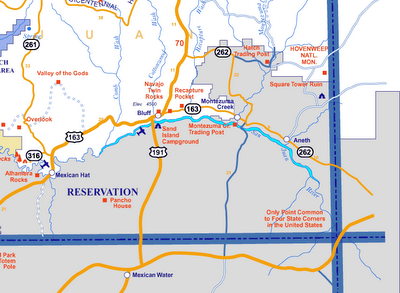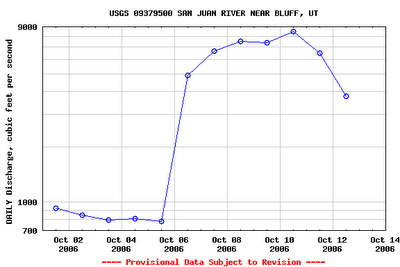
All that trash coming downriver makes you wonder about what's going on upstream.
From its headwaters along the Continental Divide in south central Colorado, the San Juan river flows southwest through Pagosa Springs to Navajo Reservoir on the Colorado-New Mexico border. Below the reservoir, the river wends about a hundred flat water miles through northwestern New Mexico before crossing briefly back into Colorado and then into Utah, where it runs along Highway 162 through the micro-towns of Aneth and Montezuma Creek before coming to Bluff.
Since I've never driven east on Highway 162, which roughly parallels the San Juan from Bluff to the Colorado border, I can't really picture what's out there. It's safe to say that there aren't many people: only 14,000 people live in all of the 8,000 square miles that constitute San Juan County. Lots of land without much infrastructure, if the only two towns along this stretch of 162 are any indication.
Aneth, population 598, is home to a Navajo Chapter headquarters and the Aneth Oil Field, which is still one of the major producing fields in the western states. Aneth is a Navajo word that can be loosely translated as "just like the devil!", which is how the Navajo described the business practices of the community's first white trader. Forty percent of Aneth's residents are unemployed, and median household income is $17,292. Median home value is only $12,500.
Ten miles downriver, the 507 residents of Montezuma Creek aren't doing a whole lot better. Median household income is almost twice that of Aneth, but the town has a 35% unemployment rate and homes have a median value of just $11,800.
With this kind of economic picture, it shouldn't come as any surprise that garbage-wise, the rural residents of San Juan County are, as they say, up a creek. The county operates one active landfill facility, located in Blanding, and three transfer stations, located in Bluff, Mexican Hat and LaSal. The county is home to 22 closed landfills, many of which are euphemistically called "unregulated disposal sites".
Consider this: If I lived in Aneth, and needed to get rid of an old fridge, I would have to load it into a pickup and drive it 45 miles to the landfill in Blanding, where, if I had known to arrive on a weekday during business hours, I would learn that a refrigerator is accepted only with a certificate proving proper freon removal and disposal. Nevermind that no one at the landfill is quite sure of where I could have that done. Alternatively, I could pay a $25 fee and let the folks at the landfill take care of it.
So, to get rid of that old fridge I need 1) about three hours of free time during the workweek, 2) a truck, 3) about $20 in gas money for the 90 mile roundtrip, and 4) $25 for the refrigerator disposal fee. In all, it would cost at least $45 to get rid of that useless piece of junk.
Or, I could throw it -- freon and all -- over the side of an arroyo. For free.



